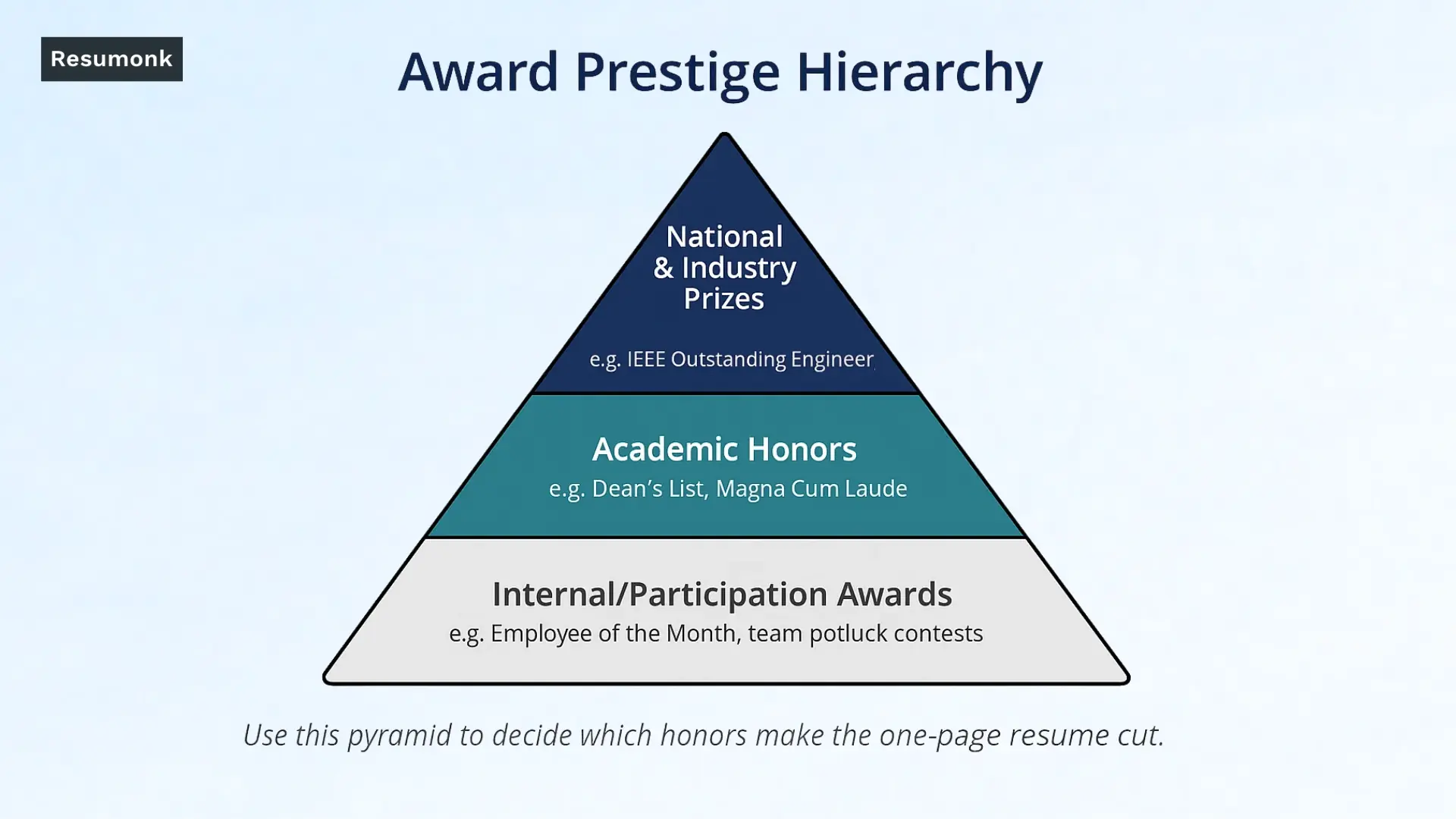
Imagine a recruiter blitzing through a pile of 200 resumes - eyes glazed, brain on autopilot, desperately hunting for something to wake them up.
Then, they spot it: a gleaming beacon of credibility - a crisp, clear list of awards.
Instantly, they know they're not dealing with an average candidate; they're looking at someone who's proven exceptional.
But wait, not every award deserves that coveted resume real estate.
In this article, we'll explore exactly how to highlight awards effectively, from selecting the right accolades and positioning them strategically to avoiding common resume blunders.
Buckle up, because you're about to transform your list of achievements into a hiring manager's best discovery of the day.
Picture a hiring manager skimming through 200 applications before her next Zoom call.
Your list of awards is like a third-party testimonial flashing "proven performer" without saying a word. Let's unpack why that matters and how to leverage it.
An award is outside proof that you exceeded a standard your peers merely met.
This instant credibility is one of the fastest signals recruiters spot when triaging resumes.
Awards also tap into social-proof bias - if an external body thought you were exceptional, busy talent scouts are likelier to agree.
Professional networking platforms even store honors in dedicated fields because they predict higher response rates to recruiter outreach.
The 2025 NACE Job Outlook survey noted that nearly 80% of employers actively scan for honors as evidence of initiative and problem-solving.
University career engagement guides stress labeling each correctly so recruiters grasp both scope and scale at a glance.
National industry prizes outrank internal employee-of-the-month certificates, with academic honors sitting between the two. Use this pyramid to decide what survives the ruthless one-page cut:

Now that you know why awards impress, here's a menu of award categories you can cherry-pick from - no participation trophies allowed.
Think external spotlights like "Salesperson of the Year," "IEEE Outstanding Engineer," or your firm's "President's Club."
Such honors confirm you've outperformed market peers, not just cubicle neighbors.
Personal branding research consistently ties these recognitions to faster promotion velocity.
For seasoned professionals, keep only marquee distinctions or those directly tied to the role.
Service-oriented accolades signal leadership and civic responsibility that corporate values statements love to champion.
Whether you nabbed first place at a TechCrunch hackathon, topped 10,000 writers in the NYT Modern Love essay contest, or bagged a regional barista championship, include the scale ("1 of 700 entrants") so recruiters feel the win's magnitude.
Award placement follows one golden rule: wherever it will get read first by the hiring manager you care about most.
Place it after your work experience (or education if you're a new grad). Here's a clean template for reference:
AWARDS & HONORS
- Governor General's Academic Medal, Canada, 2024
- IEEE Rising Star Award, 2023 - 1 of 5 honorees worldwide
- TechCrunch Disrupt Hackathon Winner, 2022 - in 600+ teams
Here's a Before & After example to show an effective way to list awards on your resume:
❌ Before: "Increased regional sales by 28%."
✅ After: "Boosted regional sales 28%, earning Salesperson of the Year (top 1% of 150 reps)."
And here's another one to showcase the correct way of listing awards:
❌ Before: "Led a 12-person service team."
✅ After: "Led a 12-person team that captured the company-wide Customer Service Excellence Award twice in 3 years."
For recent grads, let awards ride shotgun with the degree line:
University of Melbourne - B.Sc. Computer Science, 2025 Graduated Summa Cum Laude; Dean's List (6/6 terms)
If you're mid-career, move them to a separate Awards section unless the honor is directly relevant.
Use this when a marquee award is your biggest competitive edge:
Digital Marketer certified by Google, honored with the 2024 DMA Rising Star Award; drives 3× ROI on paid campaigns.
Dedicated section = clarity; in-line bullets = context.
Test both and see which version keeps the most critical awards on page one.
Think of an award on your resume like a limited-edition sneaker: it only appreciates if collectors (read: recruiters) know exactly what it is and why it's rare.
The next four mini-sections show you how to lace those bragging rights so they look intentional - not inflated.
Before you copy-paste that certificate, sanity-check each award against this quick firewall:
Career platform guides recommend this exact data set to keep hiring managers from having to Google context themselves.
Federal agencies echo the same fields - plus job-specific relevance - on USAJOBS resume instructions.
The verbs above come from established resume writing resources and career platform action-term libraries - use them to front-load impact.
Numbers make trophies shine. Consider this before and after scenario:
❌ Before: "Employee of the Quarter."
✅ After: "Employee of the Quarter - chosen from 280 staff for slashing defect rate 37%."
Should you list newest first or heaviest hitter first? Here's the cheat sheet:
Test both: whichever version keeps mission-critical trophies above the digital fold wins.
Award strategy is not one-size-fits-all.
Below are copy-ready snippets you can use in your own resume depending on where you are on the career roller-coaster.
New grads often worry their "trophy shelf" looks light. Pro tip: quality + context beats quantity.
AWARDS & HONORS
- Dean's List, University of Toronto (6/6 terms) - top 5%
- ACM International Hackathon Winner, 2024 - 1 of 350 teams
- Google Women Techmakers Scholar, 2023 - $10K merit grant
SELECTED ACCOLADES
- President's Club, Salesforce, 2024 - closed $14 M ARR (top 2%)
- CX Excellence Award, CXPA, 2023 - recognized for 92 NPS
- PMI Global Project of the Year, 2022 - Finalist
PRESTIGE RECOGNITION
- EY Entrepreneur Of The Year, Southwest Region, 2025
- Forbes Cloud 100 Leader, 2024
- Financial Times Diversity Champion, 2023
Notice the brevity - executives let press releases supply the adjectives.
Resumes are just the opening act; your awards also need prime seats on LinkedIn, CVs, and digital portfolios. Here's the omni-channel playbook.
.webp)
LinkedIn buries Honors & Awards three clicks down, so surface them deliberately:
Academic CVs breathe in pages, so awards often sit near publications:
HONORS & DISTINCTIONS
- NSF Graduate Research Fellowship, 2025–2028
- IEEE Best Paper Award, ICCV 2024
- MIT Teaching with Digital Tech Prize, 2023
University career advising services note clarity beats chronology: cluster similar honors (e.g., "Teaching Awards") to aid skim-reading committees.
Government-style résumés crave detail.
After each honor, add series/grade relevance or mission tie-in:
"Meritorious Civilian Service Award, U.S. Air Force (GS-0343) - recognized for streamlining acquisition process 18%."
That alignment helps HR prove you meet specialized experience requirements.
A trophy shelf can either spotlight your brilliance or drown it in clutter.
Recruiters keep a mental checklist of red flags - and yes, awards can trigger several of them if handled poorly.
Below are the four missteps that most often get résumés tossed in the "meh" pile.
We call résumé "red flags" anything that distracts the hiring manager from critical value propositions.This includes mile-long lists of irrelevant awards that hiring managers have never heard of.
.webp)
Rule of thumb: if the award requires explanation in casual conversation, it probably doesn't deserve precious page real estate.
❌ Before: "Employee of the Month."
✅ After: "Employee of the Month - chosen from 280 staff for cutting support ticket backlog 42%."
Former recruiting professionals consistently cite vague statements as among the biggest résumé sins because they force readers to guess at impact. Always quantify why the award matters.
Nearly 90% of recruiters in employer surveys want proof of problem-solving and teamwork when scanning new-grad résumés.
That means each award blurb should echo a skill from the posting: "Winner, CX Excellence Award - recognized for 92 NPS, directly aligning with your 'customer-obsessed' mandate."
Awards are persuasive only when they're credible, relevant, and up to date.
Below are four pro-level tactics that keep your honors shining instead of gathering dust.
Human resource professionals warn that savvy hiring teams now cross-reference every credential - including awards - during background checks and may ask for documentation if anything looks off.
Fake or exaggerated accolades are easier than ever to spot as companies adopt blockchain-style verification tools.
Keep scanned certificates or press links ready and be prepared to supply a verification contact.
Your cover letter is prime real estate to narrate the story behind the trophy - career experts suggest one concise paragraph tying the honor to a challenge you solved.
In interviews, emphasize effort and teamwork to avoid sounding boastful; framing wins around hard work and shared credit projects confidence minus arrogance.
U.S. and Canadian recruiters expect awards up front, while UK and Australian hiring managers often prefer a toned-down mention to avoid perceptions of bragging.
Adapt the placement and the adjective load accordingly - "recipient" may read better than "winner" in some Commonwealth contexts.
Your awards aren't just shiny objects collecting digital dust - they're third-party testimonials that can instantly elevate you from "another candidate" to "proven performer." Here's what you need to remember when transforming your achievements into resume gold:
When you combine strategically selected awards with compelling context and professional formatting, you're not just listing accomplishments - you're providing concrete proof that external authorities have already validated your exceptional performance.
Ready to transform your awards from resume filler into powerful credibility signals that make hiring managers stop scrolling and start scheduling interviews?
Try Resumonk now and get AI recommendations to write your resume, and then use our beautiful templates to design it.